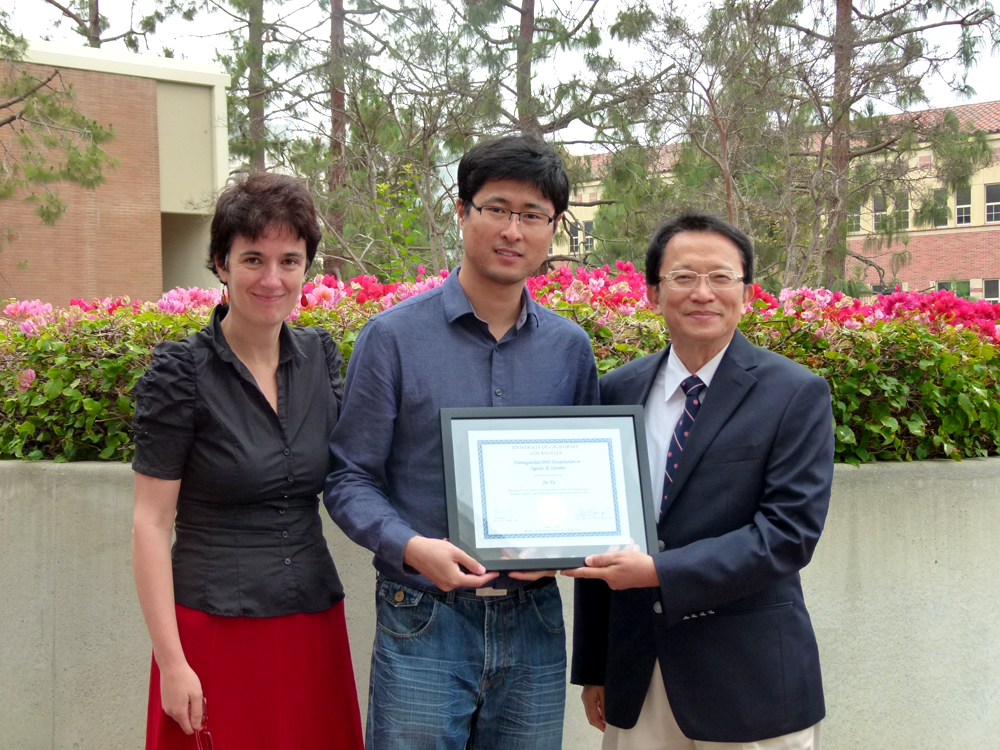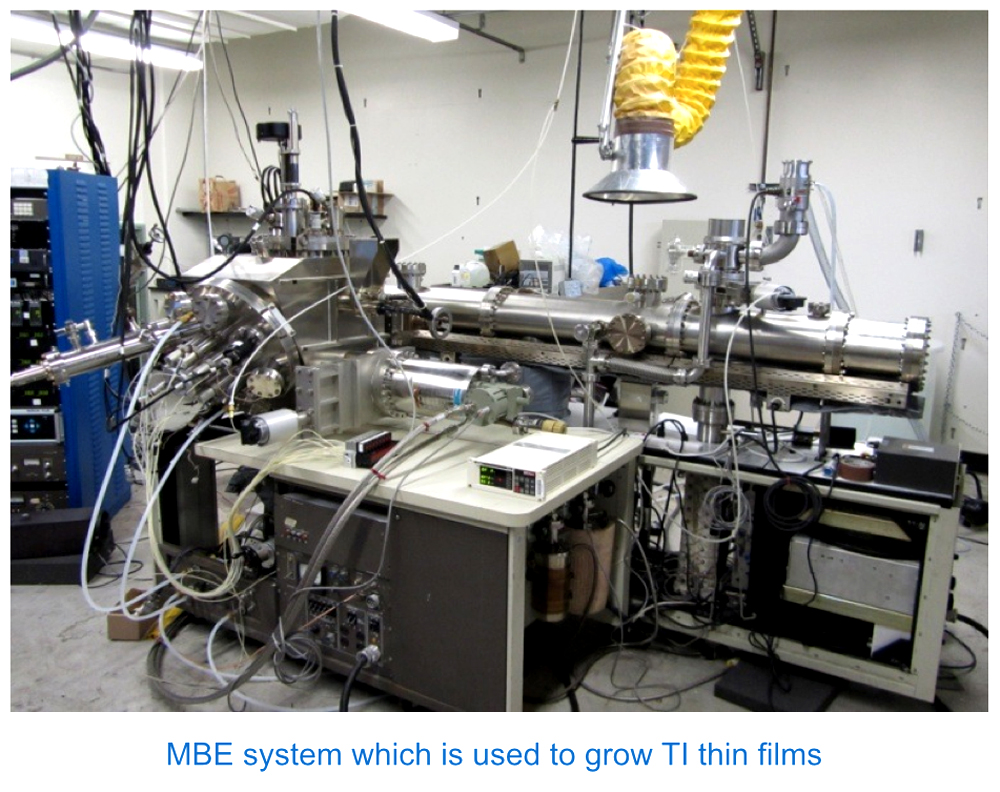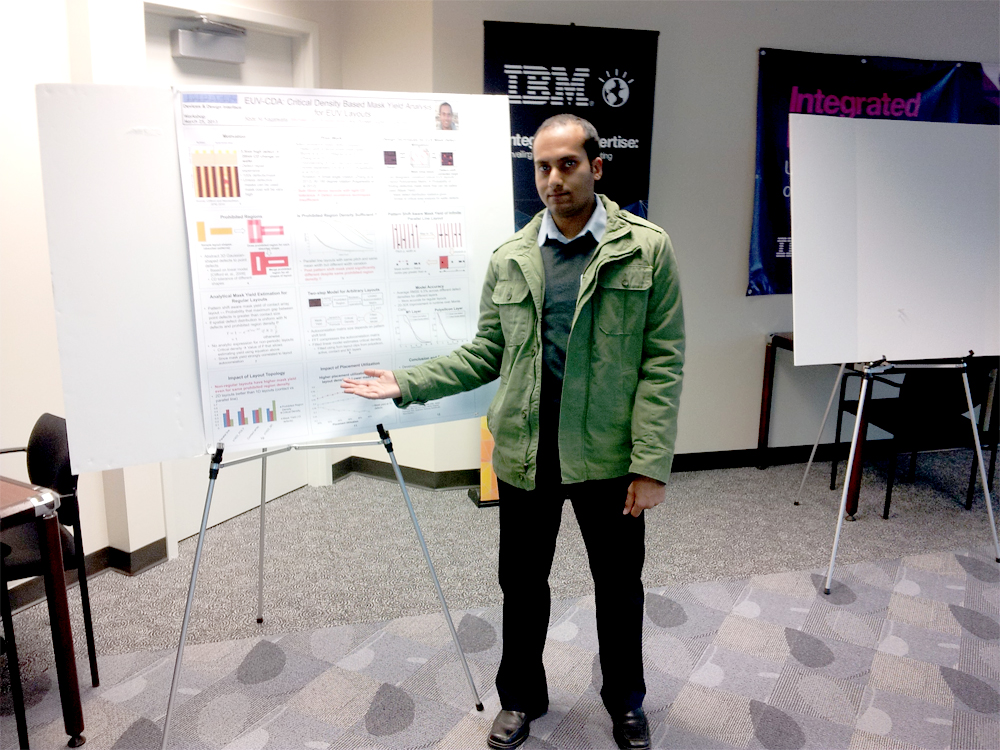This week, we highlight three recent Electrical Engineering graduates’ achievement during their time at UCLA, and take a look at where they are now.
Jie Xu (Signals & Systems)
Assistant Professor, University of Miami
Working under the guidance of Professor Mihaela van der Schaar, Jie Xu strived to op-timize networks by developing algorithms to incentivize individual agents in the network.
“Network is important because much of our society is organized in networks,” Xu said. “I think my research is very fundamental, because it provides rigorous understanding on what is really going on in the network, and how we should optimize the network.”
The first problem Xu looked into in his dissertation is the self-interested strategic agents who do not have a network-wide goal in mind. To optimize the efficiency of networks, Xu developed some theoretical algorithms to motivate these selfish agents to act in a socially-optimal manner.

Another obstacle networks run into is the non-strategic agents’ ignorance of what is going on in the whole network. For this particular challenge, Xu wrote a multi-agent learning algorithm that enables cooperations between the agents who initially did not know about each other.
“In some cases, the network doesn’t allow its agents to have explicit message ex-change,” Xu said. “If there were explicit message exchanges among the agents, then learning could have been be a lot easier. What we did enables cooperation even without explicit message exchange.”
A final installation of the project is a reputation system that bars malicious and low-quality agents from participating in the network. Based on an agent’s previous behavior when it was interacting with other agents, the system can determine the said agent’s reputation and decide if it is worthy of staying in and contributing to the network.
After earning his PhD degree at UCLA, Xu continues his cyber and cyber-physical net-works research at University of Miami, where he was recently appointed as an assistant professor in the Department of Electrical and Computer Engineering.
“A specific problem that I’m looking at is how different components or parts of the net-work can detect intrusions in a distributed yet collaborative way and in a timely manner,” Xu said. “I’m trying to build a unified framework based on the theory of cooperative learning for developing novel intrusion detection techniques.”
Xu is also investigating how security schemes can react and adapt to the increasingly smart and strategic participating nodes in the network.
Xufeng Kou (Physical & Wave Electronics)
Assistant Professor, ShanghaiTech University
Throughout his years at UCLA, Xufeng Kou has been exploring the application of novel semiconductors in electronic devices. Advised by Professor Kang L. Wang, Kou wrote his PhD dissertation on magnetic topological insulators (MTI, a type of new semiconductor materials with spontaneous magnetization).
“In order to address the critical challenge of nano-scale CMOS (complementary metal-oxide semiconductor) technology, novel electronic and spintronic devices with higher speed but lower power dissipation are highly required,” Kou said.
Initiated in 2010, Kou’s five-year research is one of the projects funded by DARPA in an attempt to investigate the device applications of a new type of semiconductor material — topological insulator (TI). Encouraged by Professor Wang, Kou began to study the feasibility of integrating TI with additional magnetic moment, investigating the exotic properties and physics based on this new system.
Kou said he considered the most important work in his project is the experimental demonstration of dissipation-less electron conduction in MTI without the presence of any external field, a phenomenon known as the quantum anomalous Hall effect, or QAHE.

“In contrast to superconductor, QAHE in principle can be realized at room temperature,” Kou explained. “And compared with quantum Hall effect, QAHE does not need large applied magnetic field; therefore, QAHE is the most promising candidate for low-power application, and the realization of QAHE in MTI hence serves as one critical break-through in this emerging field.”
The high-quality MTI thin films produced by Kou’s research group, are currently one of the only three examples in the world that can reach the QAHE state.
Kou has now moved to Shanghai, China where he joined the budding ShanghaiTech University in February as a tenure-track assistant professor in the School of Information Science and Technology. He is currently establishing his own research lab that aims to investigate and design next-generation high-speed low-power electronics and spintronic devices.
Abde Ali Kagalwalla (Circuits & Embedded Systems)
Software Engineer, Intel, Portland
Abde Ali Kagalwalla wrote his award-winning dissertation on semiconductor manufac-turing cost reduction, with the help of his advisor, Professor Puneet Gupta.
“The cost per transistor benefit of semiconductor technology scaling that has driven Moore’s law is being threatened by increasing manufacturing cost,” Kagalwalla said. “Masks, which reproduce circuit patterns on the wafer, are the biggest contributor to this manufacturing cost. The need to print sub-wavelength patterns on the wafer has significantly increased the cost and complexity of masks.”
Kagalwalla said the key theme of his research has been to propose novel computational approaches to control mask manufacturing cost by reducing the inherent pessimism of mask manufacturing steps using design information.
“We did a project to develop a benchmarking framework for a particular computational step in mask manufacturing called ‘mask fracturing’, which I think is very impactful,” Kagalwalla said. “Mask fracturing, in essence, is the problem of finding the minimum number of rectangles to cover a polygon while following certain manufacturing constraints.”
Semiconductor manufacturing is a research area geared towards industrial application. Kagalwalla said he believes his work will not only help researchers in academia, but also those in industry, develop better algorithms to solve the mask fracturing problem.

Recalling the most challenging problem in his research, Kagalwalla spoke of his paper on critical density analysis of EUV layouts.
“We wanted to understand what kind of circuit layout structures are more robust to de-fects, a particular type of defects that are seen in the next-generation patterning tech-nology called EUV lithography”, Kagalwalla said. “It was a hard problem to formulate and when I finally solved it, I was very proud.”
Kagalwalla said he found his interest in semiconductor design automation from the ex-perience of a summer internship. When he was still an undergraduate student, Kagal-walla worked on a summer project at a research lab in UC San Diego. Fascinated by semiconductor design automation, he then made the decision to apply to graduate school in the same field.
After graduation, Kagalwalla has gone into industry. He is now a software engineer at Intel’s computational lithography group in Portland, Oregon. Working alongside PhD graduates from multi-disciplinary backgrounds, Kagalwalla is exploring new algorithms and optimization/analysis techniques to help extract more resolution from existing imaging technologies, providing support for mission critical software in a production environment.
